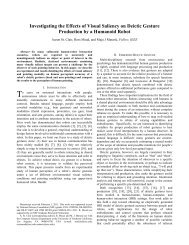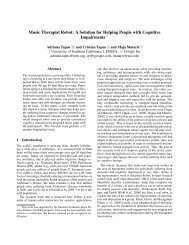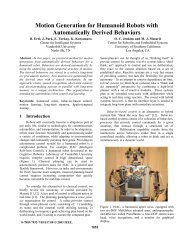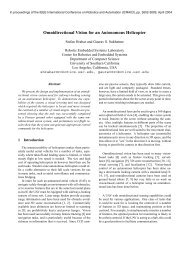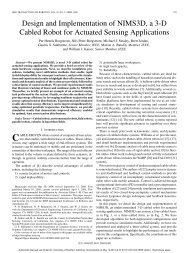A Socially Assistive Robot Exercise Coach for the Elderly
A Socially Assistive Robot Exercise Coach for the Elderly
A Socially Assistive Robot Exercise Coach for the Elderly
You also want an ePaper? Increase the reach of your titles
YUMPU automatically turns print PDFs into web optimized ePapers that Google loves.
Fasola & Matarić. A SAR <strong>Exercise</strong> <strong>Coach</strong> <strong>for</strong> <strong>the</strong> <strong>Elderly</strong>273–288. doi:10.1016/0030-5073%2878%2990054-5French, B., Tyamagundlu, D., Siewiorek, D., Smailagic, A., & Ding, D. (2008). Towardsa virtual coach <strong>for</strong> manual wheelchair users. Proceedings of International IEEESymposium of Wearable Computers, 77–80. doi:10.1109/ISWC.2008.4911589Fujiyoshi, H., & Lipton, A. (1998, October). Real-time human motion analysis by imageskeletonization. Proceedings of <strong>the</strong> Workshop on Applications of Computer Vision.doi:10.1109/ACV.1998.732852George, L., Blazer, D., Hughes, D., & Fowler, N. (1989). Social support and <strong>the</strong> outcomeof major depression. The British Journal of Psychiatry, 154, 478–485.doi:10.1192/bjp.154.4.478Heerink, M., Kröse, B., Evers, V., & Wielinga, B. (2010). Assessing acceptance ofassistive social agent technology by older adults: The Almere Model. InternationalJournal of Social <strong>Robot</strong>ics, 2(4), 361–375.Jenkins, O. C., Chu, C., & Matarić, M. J. (2004). Nonlinear spherical shells <strong>for</strong>approximate principal curves skeletonization. (University of Sou<strong>the</strong>rn Cali<strong>for</strong>nia Center<strong>for</strong> <strong>Robot</strong>ics and Embedded Systems Technical Report, CRES-04-004).Jung, Y., & Lee, K. M. (2004). Effects of physical embodiment on social presence ofsocial robots. Proceedings of Presence, 2004, 80–87.Kang, N., & Yoon, W. (2008). Age- and experience-related user behavior differences in<strong>the</strong> use of complicated electronic devices. International Journal Human-ComputerStudies, 66(6), 425–437. doi:10.1016/j.ijhcs.2007.12.003Kidd, C., Taggart, W., & Turkle, S. (2006). A sociable robot to encourage socialinteraction among <strong>the</strong> elderly. International Conference on <strong>Robot</strong>ics and Automation,3972–3976. doi:10.1109/ROBOT.2006.1642311Kidd, C. D., & Breazeal, C. (2008). <strong>Robot</strong>s at home: Understanding long-term humanrobotinteraction. IEEE/RSJ International Conference on Intelligent <strong>Robot</strong>s and Systems,3230–3235. doi:10.1109/IROS.2008.4651113Lee, K. M. (2004). Presence, explicated. Communication Theory, 14(1), 27–50.doi:10.1093/ct/14.1.27Matarić, M. J., Eriksson, J., Feil-Seifer, D. J., & Winstein, C. J. (2007). <strong>Socially</strong> assistiverobotics <strong>for</strong> post-stroke rehabilitation. Journal of NeuroEngineering and Rehabilitation,4(5). doi:10.1186/1743-0003-4-5Matsusaka, Y., Fujii, H., Okano, T., & Hara, I. (2009). Health exercise demonstrationrobot TAIZO and effects of using voice command in robot-human collaborativedemonstration. The 18th IEEE International Symposium on <strong>Robot</strong> and Human InteractiveCommunication, 472–477. doi:10.1109/ROMAN.2009.5326042McCroskey, J. C., & McCain, T. A. (1974). The measurement of interpersonal attraction.Speech Monographs, 41, 261–266. doi:10.1080/03637757409375845McMurdo, M. D., & Rennie, L. M. (1993). A controlled trial of exercise by residents ofold people's homes. Age and Ageing, 22, 11. doi:10.1093/ageing/22.1.11Moak, Z. B., & Agrawal, A. (2010). The association between perceived interpersonal33



